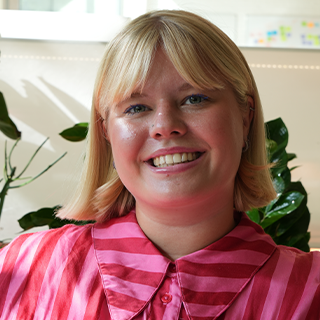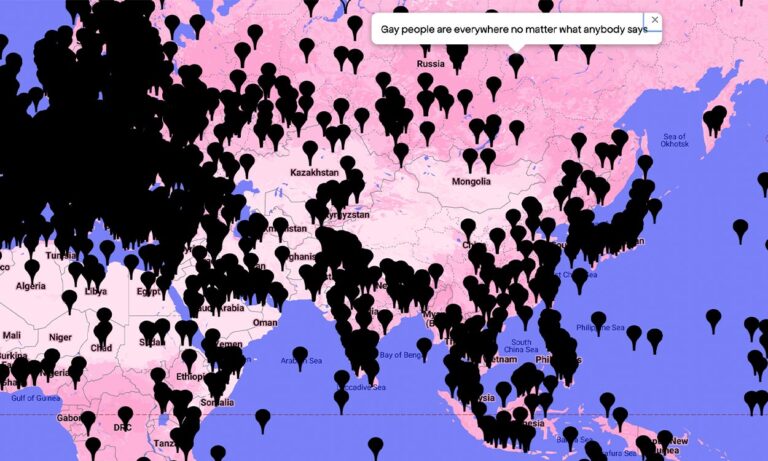Queering the Map: a community-based platform sharing queer and trans stories from across the globe
When considering romance, love and community, I never thought I’d one day think of a map. A sandy beach, a train or a ferris wheel, maybe, but not a map. For me, maps have always been associated with dog walks, pirate films and aggravated middle-aged men marching their families across the coastline.
Now, however, there’s one truly changing the map game by accumulating and gathering queer and trans stories from across the globe. And in a time where the rights of LGBTQIA+ individuals are being eroded bit by bit, Queering the Map is providing the community with a much-needed space of comfort and visibility.
What is Queering the Map?
I stumbled across Queering the Map completely accidentally. I was doing research for a different article and found myself in a bubblegum pink online maze that makes Google Maps look deathly boring in comparison. I started to navigate my way through the map, going from country to country, reading snippets of narratives touching upon every facet of connection: love, lust, forgiveness, loss, betrayal, and hope.
“I hope you know I’d swim this whole way over to you if I could.”
As stated on its site, “Queering the Map is a community generated counter-mapping platform for digitally archiving LGBTQ2IA+ experience in relation to physical space. The platform provides an interface to collaboratively record the cartography of queer life—from park benches to the middle of the ocean—in order to preserve our histories and unfolding realities, which continue to be invalidated, contested, and erased.”
It continues: “From collective action to stories of coming out, encounters with violence to moments of rapturous love, Queering the Map functions as a living archive of queer life. If it counts to you, then it counts for Queering the Map.”
“I was 14 and wrote the name of the girl I loved in the sand as the tide came in, I was closeted and hoped my feelings would wash away too.”
How did Queering the Map come to be?
I needed to know more about this project and so I reached out to Lucas LaRochelle, the creator behind the impressive project. Fast forward to a few weeks later and I was dialling into Mexico City to have a Zoom call with LaRochelle themself.
Instantly charming, they began to share their story. I wanted to know more about how the map came about and what exactly it was LaRochelle hoped to gain out of this extensive, beautiful and complicated online venture.
Starting from the very beginning, they explained: “I started Queering the Map in 2017, and the story goes that I was biking home from school and passed by the tree that I had met someone who I would eventually fall in love with, which was also the place where I had first expressed myself as trans non-binary.”
They went on to comment on how that site had held “multiple overlapping scenes of queerness and transness,” and as they continued the bike ride they “began to think about all of the other places that held that lingering significance to [them], noting that they were predominantly outside of what would be traditionally thought of as queer spaces.”
“They were in-between spaces, microspaces, alleyways, corners of parks, a shipping container in [their] childhood town, etc” LaRochelle listed. Ultimately, they got “bored” of considering simply their own experiences and decided to create a place where others could collaborate.
“The caravan park my family was living in when I cut off all my hair at 15—my first major step away from identifying as a girl.”
Trained as a designer and web developer, LaRochelle used those tools to build an online infrastructure and ask LGBTQIA+ individuals this question: “How is my expanded community thinking about queer and trans space?” And moreover, “what would it feel like to move through a world that was animated by the experiences of queer and trans people, and what kinds of futures might be made possible through the amalgamation of this kind of embodied knowledge?”
It might seem simple on the surface, but what LaRochelle has ultimately done is create an online space for queer and trans people, by queer and trans people. And with so little space for these communities to experience and document their love, Queering the Map is truly a revolutionary creation.
How has Queering the Map impacted queer and trans individuals?
Five years later and that online community now consists of over 386,000 submissions. And what’s so special about this platform is the fact that it captures the complete array of queer and trans experiences.
One of the things LaRochelle and I spoke about was how “the range of story [within the map] is much more varied than seen in dominant representations that play to a binary opposition of hyper-trauma or hyper-joy.” The archive “moves away from the representational bind that positions queer and trans people’s experience as existing in a binary of extreme trauma or ecstatic joy, and towards a space of nuance.”
One of the most entertaining aspects of these submissions has to be the level of humour people have brought to the site. Some of my favourites include a pin in the middle of the ocean which reads “gay penguins” and a pin in what appears to be outer space which reads “us gay aliens exist too.”
LaRochelle themself finds the playful nature of Queering the Map to be one of its most endearing qualities, noting: “It’s extremely serious and it’s extremely absurd all at once.” And it’s clear that the map, like so much of queer and trans humour, speaks to the early 2000s internet culture of platforms such as Tumblr. For so many members of the LGBTQIA+ community, the internet was the first place they saw representation of themselves.
Why is it important that Queering the Map recognises colonialism?
One of the most significant aspects of the platform is its land acknowledgement sidebar. It reads: “Queering the Map was initiated on the unceded traditional lands of the Kanien’kehá:ka Nation. The island currently called “Montreal” is known as Tiohtia:ke in the language of the Kanien’kehá:ka, and it has historically been a meeting place for other Indigenous nations.”
LaRochelle wanted to make sure that Queering the Map recognises this and educates visitors about the importance in acknowledging colonial pasts. They explained to me: “Queer politics has to emerge from the understanding that homophobia and transphobia are colonial constructions. Any politics that calls itself queer must contend with the histories and presents of colonisation, with particular attention to how LGBTQ+ politics are increasingly mobilised by the state to further exploitation and violence, for example the pink-washing of Israel.”
“If you’re a queer native child, just know your ancestors are proud of you. You’re loved, stay strong.”
They continued: “Specifically, with a project that’s posing questions about queer and trans space, that negotiation of space is never neutral. In the case of Montreal, which is the land of the Kanien’kehá:ka people, it’s necessary that that is the starting point. Queerness and transness are one of the many intersections of identity that inform how a space is experienced.”
As LaRochelle sees it, Queering the Map is “celebrating history with a lowercase ‘h’, rather than a capital ‘H’.” And it’s reflective of the fact that people are beginning to move away from the highly westernised perspective that queer and trans history began at Stonewall in New York.
“I survived.”
What’s the future got in store for Lucas LaRochelle?
So, what does the future look like for the creator behind his important piece of archival history? For LaRochelle, it’s all about building upon the foundation of Queering the Map in different ways and continuing to find pathways to tell queer and trans stories. They explain: “Queering the Map has been at the centre of my practice in the years following it’s launch because it’s grown so rapidly. Most of the projects I’m working on now are furthering my initial aim to build infrastructures for queer and trans people to tell our stories on our own terms.”
They’re currently working on an immersive environment and a three-part documentary that’ll explore the intersections of race, gender, sexuality, and place. The designer also told me that they have plans to create a podcast iteration of Queering the Map. Get your tissues ready.
What started as a personal journey has now completely transformed into a global community. And it’s comforting to know that the meaningful, varied, exciting, difficult, and salient lives of queer and trans individuals will be kept safe in this personal archive forever.
“We are everywhere. You are not alone. You have family, friends, supporters all over the world, even if you haven’t met them yet.”






